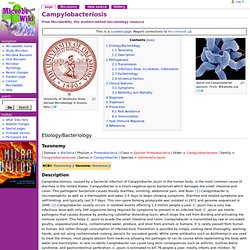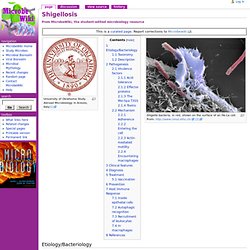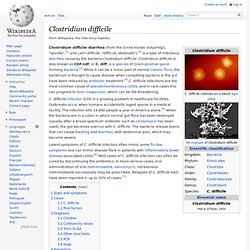

Cholera. Campylobacteriosis - MicrobeWiki. University of Oklahoma Study Abroad Microbiology in Arezzo, Italy[1] Spiral rod Campylobacter jejunum.

From: Wikipedia.org [2] Etiology/Bacteriology. Campylobacter. Salmonellosis - MicrobeWiki. Salmonella. Salmonella /ˌsælməˈnɛlə/ is a genus of rod-shaped, Gram-negative bacteria.

There are only two species of Salmonella, Salmonella bongori and Salmonella enterica, of which there are around six subspecies and innumerable serovars. The genus belongs to the same family as Escherichia, which includes the species E.coli. Salmonellae are found worldwide in both cold-blooded and warm-blooded animals, and in the environment. They cause illnesses such as typhoid fever, paratyphoid fever, and food poisoning.[1] Features[edit] Salmonella are non-spore-forming, predominantly motile enterobacteria with diameters around 0.8 to 1.5 µm, lengths from 2 to 5 µm, and peritrichous flagella, (flagella that are all around the cell body). Salmonella dans le secteur bovin et laitier. Listeriosis - MicrobeWiki. Listeriosis. Listeriosis is a bacterial infection most commonly caused by Listeria monocytogenes,[1] although L. ivanovii and L. grayi have been reported in certain cases.

Listeriosis primarily causes infections of the central nervous system (meningitis, meningoencephalitis, brain abscess, cerebritis) and bacteremia in those who are immunocompromised,[2] pregnant women, and those at the extremes of age (newborns and the elderly), as well as gastroenteritis in healthy persons who have ingested a large inoculum of the organism. Listeria is ubiquitous in the environment and is primarily transmitted via the oral route after ingestion of contaminated food products, after which the organism penetrates the intestinal tract to cause systemic infections. The diagnosis of listeriosis requires the isolation of the organism from the blood and/or the cerebrospinal fluid. Treatment includes prolonged administration of antibiotics, primarily ampicillin and gentamicin, to which the organism is usually susceptible. Cholera - MicrobeWiki. University of Oklahoma Study Abroad Microbiology in Arezzo, Italy[1] V. cholerae with flagellum.

From: Uaidintl.org [2] Etiology/Bacteriology Taxonomy. Shigellosis - MicrobeWiki. University of Oklahoma Study Abroad Microbiology in Arezzo, Italy[1] Etiology/Bacteriology Taxonomy | Domain = Bacteria | Phylum = Proteobacteria | Class = Gamma Proteobacteria | Order = Enterobacteriales | Family = Enterobacteriaceae | Genus = Shigella Description Shigellosis is caused by a bacterial infection of the Shigella genus.

Pathogenesis Virulence factors Shigella species pose a wide variety of virulence factors that allow it to adhere to the epithelium of the intestine, survive stomach acid, invade host cells, evade immune responses, and introduce toxins into the body. Acid tolerance Shigella’s ability to tolerate acid contributes to its low infectious dose, however, research has shown that acid tolerance changes according to growth phase [2]. Effector proteins Several effector proteins encoded on Shigella’s virulence plasmid allow the pathogen to invade host cells and move through the eukaryotic cytoplasm. The Mxi-Spa T3SS Toxins Shiga toxin molecular structure. Mechanism Adherence. Shigellosis. Shigellosis, also known as bacillary dysentery or Marlow Syndrome, in its most severe manifestation, is a foodborne illness caused by infection by bacteria of the genus Shigella.

Shigellosis rarely occurs in animals.[1] The causative organism is frequently found in water polluted with human feces, and is transmitted via the fecal-oral route. Clostridium difficile-associated disease - MicrobeWiki. Clostridium difficile. C. difficile infection (CDI) is a growing problem in healthcare facilities.

Outbreaks occur when humans accidentally ingest spores in a medical facility. The infection kills 14,000 people a year in America alone.[5] When the bacteria are in a colon in which normal gut flora has been destroyed (usually after a broad-spectrum antibiotic such as clindamycin has been used), the gut becomes overrun with C. difficile. The bacteria release toxins that can cause bloating and diarrhea, with abdominal pain, which may become severe.
Latent symptoms of C. difficile infection often mimic some flu-like symptoms and can mimic disease flare in patients with inflammatory bowel disease-associated colitis.[6] Mild cases of C. difficile infection can often be cured by discontinuing the antibiotics. Escherichia coli. Esperimento su E. Coli. EHEC - MicrobeWiki. Microbiology in Italy[1] Escherichia coli O157:H7 showing flagella.

From: Microbeworld.org [2] Etiology/Bacteriology Taxonomy | Domain = Bacteria | Phylum = Proteobacteria | Class = Gammaproteobacteria | Order = Enterobacteriales | Family = Enterobacteriaceae | Genus = Escherichia | species = E. coli | subspecies = O157:H7 | prototype strain = EDL933 | Description Escherichia coli O157:H7 is an emerging pathogen that causes hemorrhagic colitis. Pathogenesis Transmission E. coli O157:H7 was first isolated from hamburger and cattle are considered to be the primary reservoir for EHEC O157:H7. [3] Tissue tropism of EHEC at the rectal-anal junction and its stable colonization at this anatomical location ensures its persistence and shedding in feces [4]. Infectious dose, incubation, and colonization Contributing substantially to transmission of EHEC is its extremely low infectious dose of as few as ten microorganisms.
Epidemiology Virulence factors Clinical features Diagnosis.